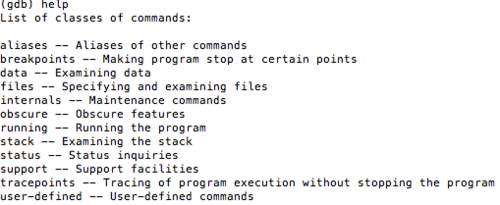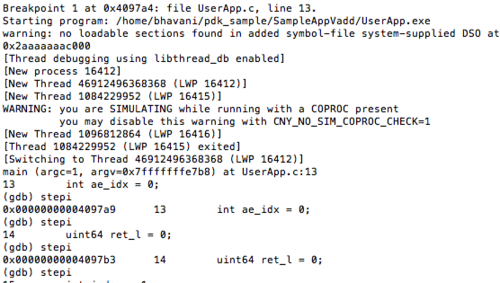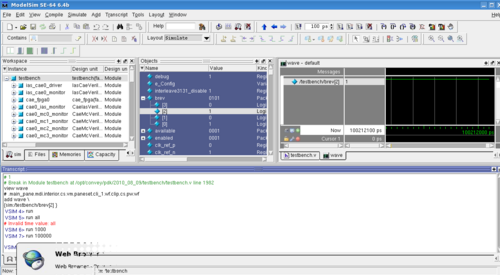Team Slytherin: Difference between revisions
Jump to navigation
Jump to search
| (52 intermediate revisions by 2 users not shown) | |||
| Line 1: | Line 1: | ||
== Team Members == | |||
* Kevin Townsend | * Kevin Townsend | ||
* Bhavani Satyanarayana Rao | * Bhavani Satyanarayana Rao | ||
* Chidvila Gaddam | * Chidvila Gaddam | ||
== Assignment1 == | |||
<hr width='100%'> | |||
=== Running the sample application with script files === | |||
<div> | |||
The | <ul><li>The runcp script located in the SampleAppVadd can be used to run the application in HW which sets the appropriate environment variables and runs the UserApp.exe </li> | ||
export CNY_PDK_PROJ = ~/pdk_sample/cae_pers_vadd | |||
./runcp | |||
<li>The run script located in the SampleAppVadd can be used to run the application in SW</li> | |||
<li>The scripts above can be used to run the application on Simulator using the "-vsim" option which sets the environment variable CNY_CAE_EMULATOR to ./run_simulation</li> | |||
./runcp -vsim | |||
or | |||
./run -vsim | |||
</ul> | |||
</div> | |||
<table border='1px'> | |||
<tr><th>Environment Variables</th><th>Software</th><th>ModelSim</th><th>Hardware</th></tr> | |||
<tr><td>CNY_SIM_THREAD</td><td>libcpSimLib2.so</td><td>libcpSimLib2.so</td><td>''unset''</td></tr> | |||
<tr><td>CNY_CAE_EMULATOR</td><td><location for CaeSimPers></td><td>./run_simulation</td><td>''unset''</td></tr> | |||
</table> | |||
=== Changes made to run the application on ModelSim === | |||
<ul> | |||
<li>Setup as explained in here [[http://wikis.ece.iastate.edu/cpre584/index.php/Convey_environment_setup]]</li> | |||
<li>Set the CNY_PDK_PROJ environment variable to the location of cae_pers_vadd</li> | |||
export CNY_PDK_PROJ = ~/pdk_sample/cae_pers_vadd | |||
<li>Copied Jones' my_makefile from the temp dir and replaced the makefile in CY_PDK_PROJ/testbench</li> | |||
<li>Add line to the makefile in testbench dir</li> | |||
CNY_PDK_MODELSIM_USER_SIM_OPTIONS= -i -do "run -all" | |||
<li>Modify the values of LIB_DIR and LDFLAGS from 32-bit to 64-bit as given below</li> | |||
LIB_DIR = lib64 | |||
LDFLAGS = -m64 | |||
</ul> | |||
[[Image:Modelsim.PNG|500px|ModelSim Snapshot]] | |||
=== Extra Credit: Exploring gdb === | |||
<ul><li>We invoked gdb using the gdb <programname> command or by using the run/runcp script files in with "-gdb" option</li> | |||
gdb UserApp.exe | |||
or | |||
./run -gdb | |||
[[Image:gdb1.png|500px|GDB Snapshot]] | |||
<li>One can find different command classes on gdb by typing help.To get details on a particular command class/command, type help on gdb followed by the name of the command class/command </li> | |||
[[Image:gdb2.png|500px|GDB help]] | |||
<li>We explored some commands like run, start (to begin execution), stepi (for single instruction stepping into a file), kill (kill a running program) and quit on gdb </li> | |||
[[Image:gdb3.png|500px|GDB]] | |||
</ul> | |||
<hr width='100%'> | |||
== Assignment2 == | |||
<hr width='100%'> | |||
=== About Sobel Algorithm === | |||
Sobel Algorithm is used for edge detection in image processing.The link[http://dasl.mem.drexel.edu/alumni/bGreen/www.pages.drexel.edu/_weg22/edge.html] explains | |||
<ul><li>Why edge detection is important?</li> | |||
<li>How sobel algorithm uses the gradient method (jump in the pixel values along edges in the images compared to the pixels around it) to detect edges in images?</li></ul> | |||
==== The Algorithm ==== | |||
<ul><li>Use Sobel masks to find the gradient of a pixel w.r.t its 8 immediate neighboring pixel values. | |||
The Sobel masks are GX={(-1,0,+1),(-2,0,+2),(-1,0,+1)) which gives the gradient in the x direction | |||
and Gy={(+1,+2,+1),(0,0,0),(-1,-2,-1)} which gives the gradient in the x direction.</li> | |||
<li>Find the approximate magnitude of the gradient using the formula</li> | |||
|G|=|Gx|+|Gy| | |||
<li>Compare |G| against the threshold values (0 and 255 in our case).</li> | |||
If (|G| > 255) then the pixel value is 0 in the output image. | |||
If (|G| < 0) then the pixel value is 255 in the output image. | |||
<li>Repeat the above steps for all the pixels in the image</li> | |||
</ul> | |||
=== C code for Sobel Algorithm === | |||
Source: Edge Detection Tutorial-Author: Bill Green (2002)[http://dasl.mem.drexel.edu/alumni/bGreen/www.pages.drexel.edu/_weg22/edge.html] | |||
for(Y=0; Y<=(originalImage.rows-1); Y++) { | |||
for(X=0; X<=(originalImage.cols-1); X++) { | |||
sumX = 0; | |||
sumY = 0; | |||
/* image boundaries */ | |||
if(Y==0 || Y==originalImage.rows-1) | |||
SUM = 0; | |||
else if(X==0 || X==originalImage.cols-1) | |||
SUM = 0; | |||
/* Convolution starts here */ | |||
else { | |||
/*-------X GRADIENT APPROXIMATION------*/ | |||
for(I=-1; I<=1; I++) { | |||
for(J=-1; J<=1; J++) { | |||
sumX = sumX + (int)( (*(originalImage.data + X + I + (Y + J)*originalImage.cols)) * GX[I+1][J+1]); | |||
} | |||
} | |||
if(sumX>255) sumX=255; | |||
if(sumX<0) sumX=0; | |||
/*-------Y GRADIENT APPROXIMATION-------*/ | |||
for(I=-1; I<=1; I++) { | |||
for(J=-1; J<=1; J++) { | |||
sumY = sumY + (int)( (*(originalImage.data + X + I + (Y + J)*originalImage.cols)) * GY[I+1][J+1]); | |||
} | |||
} | |||
if(sumY>255) sumY=255; | |||
if(sumY<0) sumY=0; | |||
SUM = abs(sumX) + abs(sumY); /*---GRADIENT MAGNITUDE APPROXIMATION (Myler p.218)----*/ | |||
} | |||
*(edgeImage.data + X + Y*originalImage.cols) = 255 - (unsigned char)(SUM); /* make edges black and background white */ | |||
fwrite( (edgeImage.data + X + Y*originalImage.cols), sizeof(char), 1, bmpOutput); | |||
=== Profiling C code Using gprof === | |||
Compile the c code with -pg option | |||
gcc -pg -lm edgesob.c | |||
Run the a.out file | |||
./a.out lena.bmp | |||
Execute the gprof command, provide it with the executable file name and pipe the output to a text file. | |||
Note the use of -z option.Unless the `-z' option is given, functions with no apparent time spent in them, | |||
and no apparent calls to them, are not mentioned. | |||
source:The GNU Profiler-Jay Fenlason and Richard Stallman[http://www.cs.utah.edu/dept/old/texinfo/as/gprof_toc.html] | |||
gprof -b -z a.out >result.txt | |||
The output of gprof: | |||
The link [http://www.cs.utah.edu/dept/old/texinfo/as/gprof.html#SEC5] explains on how to understand a Flat Profile. | |||
====Flat profile==== | |||
Each sample counts as 0.01 seconds. | |||
% cumulative self self total | |||
time seconds seconds calls Ts/call Ts/call name | |||
100.31 0.03 0.03 main | |||
0.00 0.03 0.00 4 0.00 0.00 getImageInfo | |||
0.00 0.03 0.00 1 0.00 0.00 copyColorTable | |||
0.00 0.03 0.00 1 0.00 0.00 copyImageInfo | |||
0.00 0.03 0.00 __do_global_ctors_aux | |||
0.00 0.03 0.00 __do_global_dtors_aux | |||
0.00 0.03 0.00 __gmon_start__ | |||
0.00 0.03 0.00 __libc_csu_fini | |||
0.00 0.03 0.00 __libc_csu_init | |||
0.00 0.03 0.00 _fini | |||
0.00 0.03 0.00 _init | |||
0.00 0.03 0.00 _start | |||
0.00 0.03 0.00 atexit | |||
0.00 0.03 0.00 call_gmon_start | |||
0.00 0.03 0.00 data_start | |||
0.00 0.03 0.00 frame_dummy | |||
====Call graph==== | |||
The link [http://www.cs.utah.edu/dept/old/texinfo/as/gprof.html#SEC6] explains on how to read the call graph. | |||
granularity: each sample hit covers 2 byte(s) for 33.23% of 0.03 seconds | |||
index % time self children called name | |||
<spontaneous> | |||
[1] 100.0 0.03 0.00 main [1] | |||
0.00 0.00 4/4 getImageInfo [2] | |||
0.00 0.00 1/1 copyImageInfo [4] | |||
0.00 0.00 1/1 copyColorTable [3] | |||
----------------------------------------------- | |||
0.00 0.00 4/4 main [1] | |||
[2] 0.0 0.00 0.00 4 getImageInfo [2] | |||
----------------------------------------------- | |||
0.00 0.00 1/1 main [1] | |||
[3] 0.0 0.00 0.00 1 copyColorTable [3] | |||
----------------------------------------------- | |||
0.00 0.00 1/1 main [1] | |||
[4] 0.0 0.00 0.00 1 copyImageInfo [4] | |||
----------------------------------------------- | |||
<spontaneous> | |||
[7] 0.0 0.00 0.00 atexit [7] | |||
----------------------------------------------- | |||
<spontaneous> | |||
[8] 0.0 0.00 0.00 call_gmon_start [8] | |||
----------------------------------------------- | |||
<spontaneous> | |||
[9] 0.0 0.00 0.00 data_start [9] | |||
----------------------------------------------- | |||
<spontaneous> | |||
[10] 0.0 0.00 0.00 frame_dummy [10] | |||
----------------------------------------------- | |||
<spontaneous> | |||
[11] 0.0 0.00 0.00 __do_global_ctors_aux [11] | |||
----------------------------------------------- | |||
<spontaneous> | |||
[12] 0.0 0.00 0.00 __do_global_dtors_aux [12] | |||
----------------------------------------------- | |||
<spontaneous> | |||
[13] 0.0 0.00 0.00 __gmon_start__ [13] | |||
----------------------------------------------- | |||
<spontaneous> | |||
[14] 0.0 0.00 0.00 __libc_csu_fini [14] | |||
----------------------------------------------- | |||
<spontaneous> | |||
[15] 0.0 0.00 0.00 __libc_csu_init [15] | |||
----------------------------------------------- | |||
<spontaneous> | |||
[16] 0.0 0.00 0.00 _fini [16] | |||
----------------------------------------------- | |||
<spontaneous> | |||
[17] 0.0 0.00 0.00 _init [17] | |||
----------------------------------------------- | |||
<spontaneous> | |||
[18] 0.0 0.00 0.00 _start [18] | |||
----------------------------------------------- | |||
=== Software emulation of HW === | |||
Application file : [[Team Slytherin - Software emulation source code]] | |||
Latest revision as of 21:26, 22 February 2012
Team Members
- Kevin Townsend
- Bhavani Satyanarayana Rao
- Chidvila Gaddam
Assignment1
Running the sample application with script files
- The runcp script located in the SampleAppVadd can be used to run the application in HW which sets the appropriate environment variables and runs the UserApp.exe export CNY_PDK_PROJ = ~/pdk_sample/cae_pers_vadd ./runcp
- The run script located in the SampleAppVadd can be used to run the application in SW
- The scripts above can be used to run the application on Simulator using the "-vsim" option which sets the environment variable CNY_CAE_EMULATOR to ./run_simulation ./runcp -vsim or ./run -vsim
| Environment Variables | Software | ModelSim | Hardware |
|---|---|---|---|
| CNY_SIM_THREAD | libcpSimLib2.so | libcpSimLib2.so | unset |
| CNY_CAE_EMULATOR | <location for CaeSimPers> | ./run_simulation | unset |
Changes made to run the application on ModelSim
- Setup as explained in here [[1]]
- Set the CNY_PDK_PROJ environment variable to the location of cae_pers_vadd export CNY_PDK_PROJ = ~/pdk_sample/cae_pers_vadd
- Copied Jones' my_makefile from the temp dir and replaced the makefile in CY_PDK_PROJ/testbench
- Add line to the makefile in testbench dir CNY_PDK_MODELSIM_USER_SIM_OPTIONS= -i -do "run -all"
- Modify the values of LIB_DIR and LDFLAGS from 32-bit to 64-bit as given below LIB_DIR = lib64 LDFLAGS = -m64
Extra Credit: Exploring gdb
- We invoked gdb using the gdb <programname> command or by using the run/runcp script files in with "-gdb" option gdb UserApp.exe or ./run -gdb
- One can find different command classes on gdb by typing help.To get details on a particular command class/command, type help on gdb followed by the name of the command class/command
- We explored some commands like run, start (to begin execution), stepi (for single instruction stepping into a file), kill (kill a running program) and quit on gdb



Assignment2
About Sobel Algorithm
Sobel Algorithm is used for edge detection in image processing.The link[2] explains
- Why edge detection is important?
- How sobel algorithm uses the gradient method (jump in the pixel values along edges in the images compared to the pixels around it) to detect edges in images?
The Algorithm
- Use Sobel masks to find the gradient of a pixel w.r.t its 8 immediate neighboring pixel values. The Sobel masks are GX={(-1,0,+1),(-2,0,+2),(-1,0,+1)) which gives the gradient in the x direction and Gy={(+1,+2,+1),(0,0,0),(-1,-2,-1)} which gives the gradient in the x direction.
- Find the approximate magnitude of the gradient using the formula |G|=|Gx|+|Gy|
- Compare |G| against the threshold values (0 and 255 in our case). If (|G| > 255) then the pixel value is 0 in the output image. If (|G| < 0) then the pixel value is 255 in the output image.
- Repeat the above steps for all the pixels in the image
C code for Sobel Algorithm
Source: Edge Detection Tutorial-Author: Bill Green (2002)[3]
for(Y=0; Y<=(originalImage.rows-1); Y++) {
for(X=0; X<=(originalImage.cols-1); X++) {
sumX = 0;
sumY = 0;
/* image boundaries */
if(Y==0 || Y==originalImage.rows-1)
SUM = 0;
else if(X==0 || X==originalImage.cols-1)
SUM = 0;
/* Convolution starts here */
else {
/*-------X GRADIENT APPROXIMATION------*/
for(I=-1; I<=1; I++) {
for(J=-1; J<=1; J++) {
sumX = sumX + (int)( (*(originalImage.data + X + I + (Y + J)*originalImage.cols)) * GX[I+1][J+1]);
}
}
if(sumX>255) sumX=255;
if(sumX<0) sumX=0;
/*-------Y GRADIENT APPROXIMATION-------*/
for(I=-1; I<=1; I++) {
for(J=-1; J<=1; J++) {
sumY = sumY + (int)( (*(originalImage.data + X + I + (Y + J)*originalImage.cols)) * GY[I+1][J+1]);
}
}
if(sumY>255) sumY=255;
if(sumY<0) sumY=0;
SUM = abs(sumX) + abs(sumY); /*---GRADIENT MAGNITUDE APPROXIMATION (Myler p.218)----*/
}
*(edgeImage.data + X + Y*originalImage.cols) = 255 - (unsigned char)(SUM); /* make edges black and background white */
fwrite( (edgeImage.data + X + Y*originalImage.cols), sizeof(char), 1, bmpOutput);
Profiling C code Using gprof
Compile the c code with -pg option
gcc -pg -lm edgesob.c
Run the a.out file
./a.out lena.bmp
Execute the gprof command, provide it with the executable file name and pipe the output to a text file. Note the use of -z option.Unless the `-z' option is given, functions with no apparent time spent in them, and no apparent calls to them, are not mentioned. source:The GNU Profiler-Jay Fenlason and Richard Stallman[4]
gprof -b -z a.out >result.txt
The output of gprof: The link [5] explains on how to understand a Flat Profile.
Flat profile
Each sample counts as 0.01 seconds. % cumulative self self total time seconds seconds calls Ts/call Ts/call name 100.31 0.03 0.03 main 0.00 0.03 0.00 4 0.00 0.00 getImageInfo 0.00 0.03 0.00 1 0.00 0.00 copyColorTable 0.00 0.03 0.00 1 0.00 0.00 copyImageInfo 0.00 0.03 0.00 __do_global_ctors_aux 0.00 0.03 0.00 __do_global_dtors_aux 0.00 0.03 0.00 __gmon_start__ 0.00 0.03 0.00 __libc_csu_fini 0.00 0.03 0.00 __libc_csu_init 0.00 0.03 0.00 _fini 0.00 0.03 0.00 _init 0.00 0.03 0.00 _start 0.00 0.03 0.00 atexit 0.00 0.03 0.00 call_gmon_start 0.00 0.03 0.00 data_start 0.00 0.03 0.00 frame_dummy
Call graph
The link [6] explains on how to read the call graph.
granularity: each sample hit covers 2 byte(s) for 33.23% of 0.03 seconds
index % time self children called name
<spontaneous>
[1] 100.0 0.03 0.00 main [1]
0.00 0.00 4/4 getImageInfo [2]
0.00 0.00 1/1 copyImageInfo [4]
0.00 0.00 1/1 copyColorTable [3]
-----------------------------------------------
0.00 0.00 4/4 main [1]
[2] 0.0 0.00 0.00 4 getImageInfo [2]
-----------------------------------------------
0.00 0.00 1/1 main [1]
[3] 0.0 0.00 0.00 1 copyColorTable [3]
-----------------------------------------------
0.00 0.00 1/1 main [1]
[4] 0.0 0.00 0.00 1 copyImageInfo [4]
-----------------------------------------------
<spontaneous>
[7] 0.0 0.00 0.00 atexit [7]
-----------------------------------------------
<spontaneous>
[8] 0.0 0.00 0.00 call_gmon_start [8]
-----------------------------------------------
<spontaneous>
[9] 0.0 0.00 0.00 data_start [9]
-----------------------------------------------
<spontaneous>
[10] 0.0 0.00 0.00 frame_dummy [10]
-----------------------------------------------
<spontaneous>
[11] 0.0 0.00 0.00 __do_global_ctors_aux [11]
-----------------------------------------------
<spontaneous>
[12] 0.0 0.00 0.00 __do_global_dtors_aux [12]
-----------------------------------------------
<spontaneous>
[13] 0.0 0.00 0.00 __gmon_start__ [13]
-----------------------------------------------
<spontaneous>
[14] 0.0 0.00 0.00 __libc_csu_fini [14]
-----------------------------------------------
<spontaneous>
[15] 0.0 0.00 0.00 __libc_csu_init [15]
-----------------------------------------------
<spontaneous>
[16] 0.0 0.00 0.00 _fini [16]
-----------------------------------------------
<spontaneous>
[17] 0.0 0.00 0.00 _init [17]
-----------------------------------------------
<spontaneous>
[18] 0.0 0.00 0.00 _start [18]
-----------------------------------------------
Software emulation of HW
Application file : Team Slytherin - Software emulation source code
